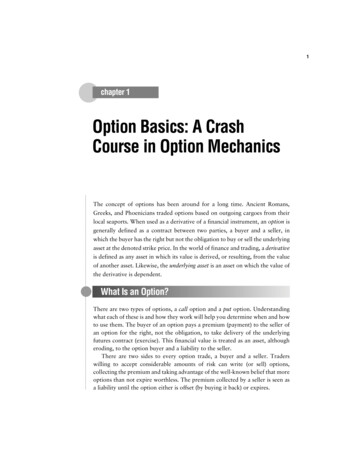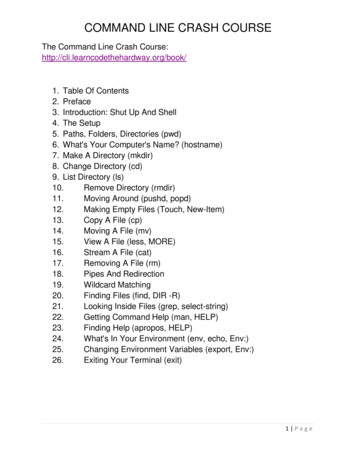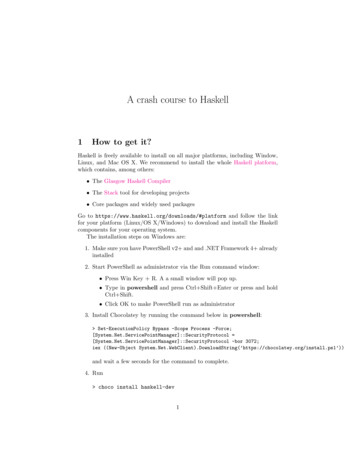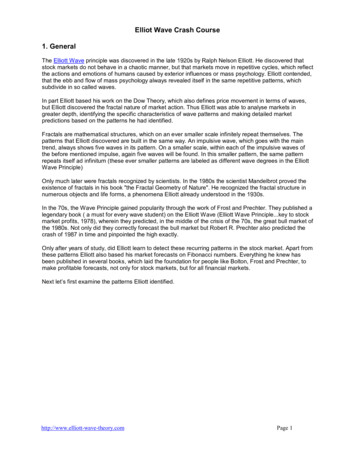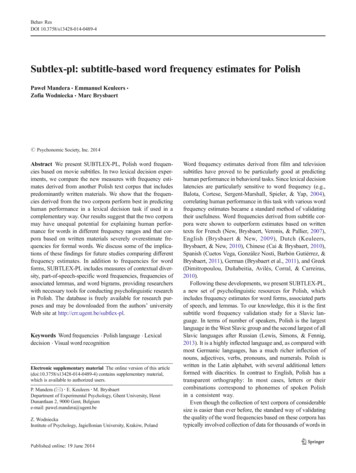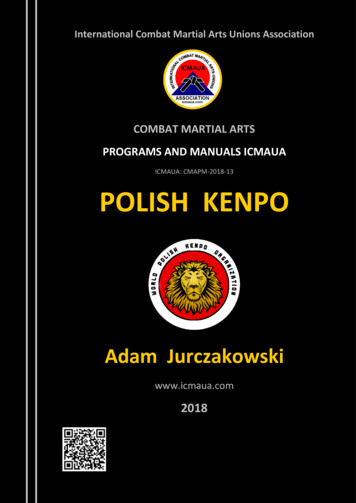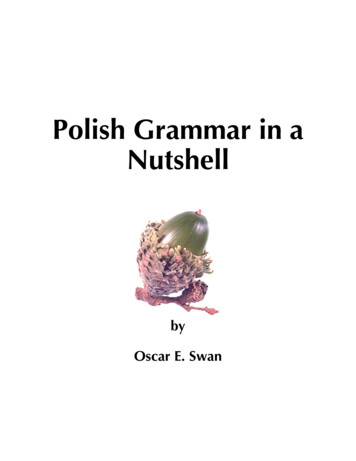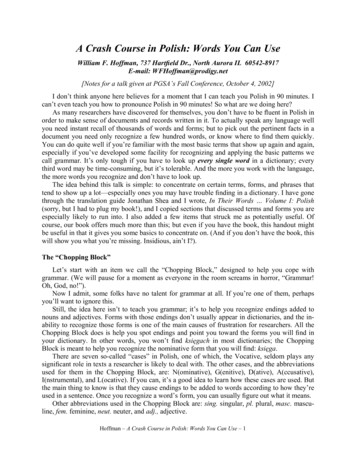
Transcription
A Crash Course in Polish: Words You Can UseWilliam F. Hoffman, 737 Hartfield Dr., North Aurora IL 60542-8917E-mail: WFHoffman@prodigy.net[Notes for a talk given at PGSA’s Fall Conference, October 4, 2002]I don’t think anyone here believes for a moment that I can teach you Polish in 90 minutes. Ican’t even teach you how to pronounce Polish in 90 minutes! So what are we doing here?As many researchers have discovered for themselves, you don’t have to be fluent in Polish inorder to make sense of documents and records written in it. To actually speak any language wellyou need instant recall of thousands of words and forms; but to pick out the pertinent facts in adocument you need only recognize a few hundred words, or know where to find them quickly.You can do quite well if you’re familiar with the most basic terms that show up again and again,especially if you’ve developed some facility for recognizing and applying the basic patterns wecall grammar. It’s only tough if you have to look up every single word in a dictionary; everythird word may be time-consuming, but it’s tolerable. And the more you work with the language,the more words you recognize and don’t have to look up.The idea behind this talk is simple: to concentrate on certain terms, forms, and phrases thattend to show up a lot—especially ones you may have trouble finding in a dictionary. I have gonethrough the translation guide Jonathan Shea and I wrote, In Their Words Volume I: Polish(sorry, but I had to plug my book!), and I copied sections that discussed terms and forms you areespecially likely to run into. I also added a few items that struck me as potentially useful. Ofcourse, our book offers much more than this; but even if you have the book, this handout mightbe useful in that it gives you some basics to concentrate on. (And if you don’t have the book, thiswill show you what you’re missing. Insidious, ain’t I?).The “Chopping Block”Let’s start with an item we call the “Chopping Block,” designed to help you cope withgrammar. (We will pause for a moment as everyone in the room screams in horror, “Grammar!Oh, God, no!”).Now I admit, some folks have no talent for grammar at all. If you’re one of them, perhapsyou’ll want to ignore this.Still, the idea here isn’t to teach you grammar; it’s to help you recognize endings added tonouns and adjectives. Forms with those endings don’t usually appear in dictionaries, and the inability to recognize those forms is one of the main causes of frustration for researchers. All theChopping Block does is help you spot endings and point you toward the forms you will find inyour dictionary. In other words, you won’t find księgach in most dictionaries; the ChoppingBlock is meant to help you recognize the nominative form that you will find: księga.There are seven so-called “cases” in Polish, one of which, the Vocative, seldom plays anysignificant role in texts a researcher is likely to deal with. The other cases, and the abbreviationsused for them in the Chopping Block, are: N(ominative), G(enitive), D(ative), A(ccusative),I(nstrumental), and L(ocative). If you can, it’s a good idea to learn how these cases are used. Butthe main thing to know is that they cause endings to be added to words according to how they’reused in a sentence. Once you recognize a word’s form, you can usually figure out what it means.Other abbreviations used in the Chopping Block are: sing. singular, pl. plural, masc. masculine, fem. feminine, neut. neuter, and adj., adjective.Hoffman – A Crash Course in Polish: Words You Can Use – 1
The Chopping BlockEndingCase(s)Part of speechExample-aG/A masc. sing.G neut. sing.nounN/A neut. pl.-ą-achA/I fem. sing.L pl.noun/adj.noun-amiI pl.noun-ę-(i)eA fem. sing.D/L sing.N/A pl.nounnoun-egoA sing./pl.G/A sing.masc./neut.adj.adj. (also ifused as noun)-(i)ejG/D/L fem. sing.-em-emu-i-ich-imadj. (also ifused as noun)I sing. masc./neut.nounL sing. masc./neut.adj.D sing. masc./neut. adj. (also ifused as noun)G/D/L fem. sing.,nounG sing./pl., N/A pl.-imiG/A/L pl.I/L sing.,D pl.I pl.adj.adj. (also ifused as noun)adj.-omD pl.nounReplace withResultsyn Janado mieszkanianazwa miastapolaciałaKwaśniewskąw dokumentachw księgachw Uhercachw Stawiskachw miastachw Borzymachmateriałamicyframizebraniamimiędzy Rudnikamisłowamiza BorzymamiAnnęw Krakowiew Warszawiecórce*w Wesołowiedobresyn Antoniego Dębskiegoz PorytegowoźnegoOlszewskiejw Korczowejmiędzy Janemw ZakopanemAntoniemuAlojzemuw Łodzisyn Jadwigiz Pogorzeliz Chrzanowskichz Antonim -e-y-a-anothing-enothing-ynothing-a-e-i or -adelete –mdelete –mdelete órkaWesołowodobryAntoni oniAlojzyŁódźJadwigaPogorzeleChrzanowskiAntoni leStawiskiMoniuszkoBorzymy* see Consonant Alternations, page 4Hoffman – A Crash Course in Polish: Words You Can Use – 2
-ówG/A masc. pl.-owi-owie-uD masc. sing.N masc. pl.G/D/L sing.,masc./neut.-y-ych-ymG/D/L fem. sing.,N/G/A pl.G/A/L pl.I/L sing., D pl.-ymiI pl.nounz Charłanówz Maciorówz Mikłaszówz Krysiakówz Mołodziejkówz MłynównounJanowinounpanowie, Zarębowienounw Toruniuw Zaskrodziuw Ryszczewkunounw Bydgoszczysyn Karolinyadj.w Starych Gutachadj. (also if w Starym Mieścieused as noun) o Wincentymadj.między innyminothing-a-e-i-o-ynothingnothing, -a, aszeKrysiakiMołodziejkoMłynyJanpan, aStare GutyStare MiastoWincentyinnyIn the genitive plural of many nouns (mainly feminine and neuter), grammar calls for noendings. To get the nominative form, one must add an ending, rather than delete one:ze Stawisk Stawiskiz Kielc Kielceze Żdziar ŻdziaryIn similar environments one may need to delete a “fill” or “epenthetic” vowel. This is a vowelinserted in some forms—usually between two consonants at the end of a word, to make the wordeasier to pronounce—that drops out in other forms.z Borek Borkiz Ejszyszek EjszyszkiConversely, fill vowels may have to be restored when deleting endings from nouns containingcertain suffixes, notably –iec or –ec and -ek.z Myszyńca (genitive) Myszyniecz Sielca (genitive) Sielecz Rynku (genitive) Rynekw Myszyńcu (locative) Myszyniecz Ugorka (genitive) Ugorekz Mazurków (genitive) MazurekDropping the KreskaNo, this isn’t an obscure Polish folk custom. The kreska is the accent placed over the consonants ć, ń, ś, and ź. When a noun ends with a kreska consonant, and grammar calls for adding anending, the kreska is dropped and an –i- is inserted before the ending:Staroń ending –ów StaroniówKrzywoś ending –ów KrzywosiówPoznań ending –u PoznaniuŁoś ending –a ŁosiaWhen you encounter such a name with an ending in the text of a document, you must delete boththe ending and the inserted –i-, and restore the kreska, to arrive at the nominative form, the onethat appears in a dictionary or gazetteer, or on a map.Vowel Shifts and AlternationsThe only feature of this complicated phonetic phenomenon likely to affect the researcher isthe shift of the vowel ó to simple o when endings are attached. This will most often be encounHoffman – A Crash Course in Polish: Words You Can Use – 3
tered when dealing with the common place name ending –ów: Kraków w Krakowie,Chrzanów w ChrzanowieOther possibilities, less frequently encountered, are a e , ą ę, and ó/o e:a e:ą ę:ó/o e:Wierzchlas w Wierzchlesiemąż o mężukościół w kościele or jezioro o jezierzeConsonant AlternationsBesides dealing with removing endings and substituting others, researchers also need to beaware of consonant alternations in the stems of nouns when certain endings are attached, especially in the locative singular case. Thus after prepositions such as w and na (among others) thatindicate a location or status in which something is taking place (as opposed to change of locationor status), nouns have locative case endings. Researchers need to recognize this because the phonetic shape of place names in documents may need to be altered one more time, even after theendings are removed, to arrive at the form of a place name given on a map or in a gazetteer. Themost common of these alternations are:Map nameName in Locativech szBirwicha w Birwiszed dziPiwoda w Piwodzieg dzPraga w Pradzek cAdamówka w Adamówceł lPiła w Piler rzWara w Warzesł ślJasło w Jaślesn śniKrosno w Krośniest ścieNowe Miasto w Nowym Mieściet ciHuta w Huciezd ździGniazdo w Gnieździe (note the a e vowel change)zn źniPilzno w PilźnieEXPRESSIONS OF TIME AND DATESThe following expressions, denoting parts of the day and the like, immediately follow thehour:po północy — after midnightpo południu — after noonprzed północą — before midnightprzed południem — before noonrano — morningwieczorem — in the eveningw nocy — at nighto północy — at midnightw południu — at noonSo o godzinie trzeciej po południu is literally “at the 3rd hour after midday,” in other words, “at 3p.m.” Record keepers sometimes chose different styles to express the same thought, so that youmay see o piątej godzinie rano, “at five o’clock in the morning,” or o piątej godzinie po północy,“at five o’clock after midnight,” to designate 5 a.m.Hoffman – A Crash Course in Polish: Words You Can Use – 4
Other time expressions:dziś or dzisiaj — todayonegdaj — two days agoprzedwczoraj — the day before yesterdaywczoraj — yesterdayA variant of the above was to use the preposition w or na plus the word for day (dzień) in thelocative case form dniu plus an adjectival form of the time expressions noted in the list above.This produces such expressions as:w dniu dzisiejszym — today, literally “in the day of today”w dniu wczorajszym — yesterdayw dniu przedwczorajszym — the day before yesterdayw dniu onegdajszym — two days agoAnother way of expressing the same thing was to use the genitive singular of dzień, “day,” plusthe genitive masculine forms of the adjectives just shown, with no preposition, e. g., dzisiejszegodnia, “today,” and wczorajszego dnia, “yesterday.”DATES AND NUMERALSIn modern Polish dates are usually given in the following order: day/month/year. But in 19thcentury records the year is in first position, almost always written out in words, followed by theday and then the month (or vice versa), all with the appropriate case endings. The year is almostalways marked by use of roku or w roku, meaning “in the year of.”Names of the MonthsNominative/Genitive EnglishIIIIIIIVVVIstyczeń, stycznialuty, lutegomarzec, marcakwiecień, kwietniamaj, majaczerwiec, GenitiveVIIVIIIIXXXIXIIEnglishlipiec, lipcaJulysierpień, sierpniaAugustwrzesień, wrześniaSeptemberpaździernik, października Octoberlistopad, listopadaNovembergrudzień, grudniaDecemberNumeralsCardinalOrdinal1 jeden (masc.), jedna(fem.), jedno (neut.)2 dwa, dwie3 trzy4 cztery5 pięć6 sześć7 siedem or siedm8 osiem or ośm9 dziewięć10 dziesięć11 jedenaście12 a jedendwadzieścia dwadwadzieścia trzydwadzieścia czterydwadzieścia nastyosiemnastydziewiętnastydwudziestydwudziesty pierwszydwudziesty drugidwudziesty trzecidwudziesty czwartydwudziety piątyHoffman – A Crash Course in Polish: Words You Can Use – 5
262728293031405060708090100dwadzieścia sześćdwadzieścia siedemdwadzieścia osiemdwadzieścia dziewięćtrzydzieścitrzydzieści dwudziesty szóstydwudziesty siódmydwudziesty ósmydwudziesty dziewiątytrydziestytrzydziesty emsetosiemsetdziewięćsettysiąctysiąc sześćsettysiąc siedemsettysiąc osiemsettysiąc etnytysiącznytysiąc sześćsetnytysiąc siedemsetnytysiąc osiemsetnytysiąc dziewięćsetnyDates in the records are usually quoted in the genitive case and employ ordinal numbers forthe last two digits of the year, as well as the day. The first two digits of the year are usually cardinal numbers with no case endings, although some record keepers converted these, too, into ordinal numbers with case endings. Thus the date November 28, 1869 would be written out as follows (genitive endings are emphasized in boldface type):.roku tysiąc ośmset sześćdziesiątego dziewiątego dnia dwudziestego ósmegomiesiąca listopada.Note the following terms:rok, genitive roku, plural forms lata, lat — yeardzień, genitive singular dnia, locative singular dniu — daymiesiąc, genitive miesiąca, genitive plural miesięcy — monthSo a word-by-word, literal translation of the phrase above would be “of the year [one] thousandeight hundred sixty-ninth, of the day twenty-eighth, of the month of November.” Or as we’d say,“On November 28, 1869.”Days of the WeekEnglishDictionary form“On ” [accusative �teksobotaw niedzielęw poniedziałekwe wtorekw środęw czwartekw piątekw sobotęTERMS FOR FAMILY RELATIONSHIPSTo make this list a little easier for you to use, these terms are alphabetized according to theorder English-speakers would expect, which can differ substantially from the order in which onewould find them in a Polish dictionary. All nouns are given with indication of gender (m.
Hoffman – A Crash Course in Polish: Words You Can Use – 2 The Chopping Block Ending Case(s) Part of speech Example Replace with Result -a G/A masc. sing. noun syn Jana nothing Jan G neut. sing. do mieszkania -e mieszkanie nazwa miasta -o miasto N/A neut. pl. pola -e pole ciała -o ciało -ą A/I fem. sing. noun/adj. Kwaśniewską-a KwaśniewskaFile Size: 300KBPage Count: 15
